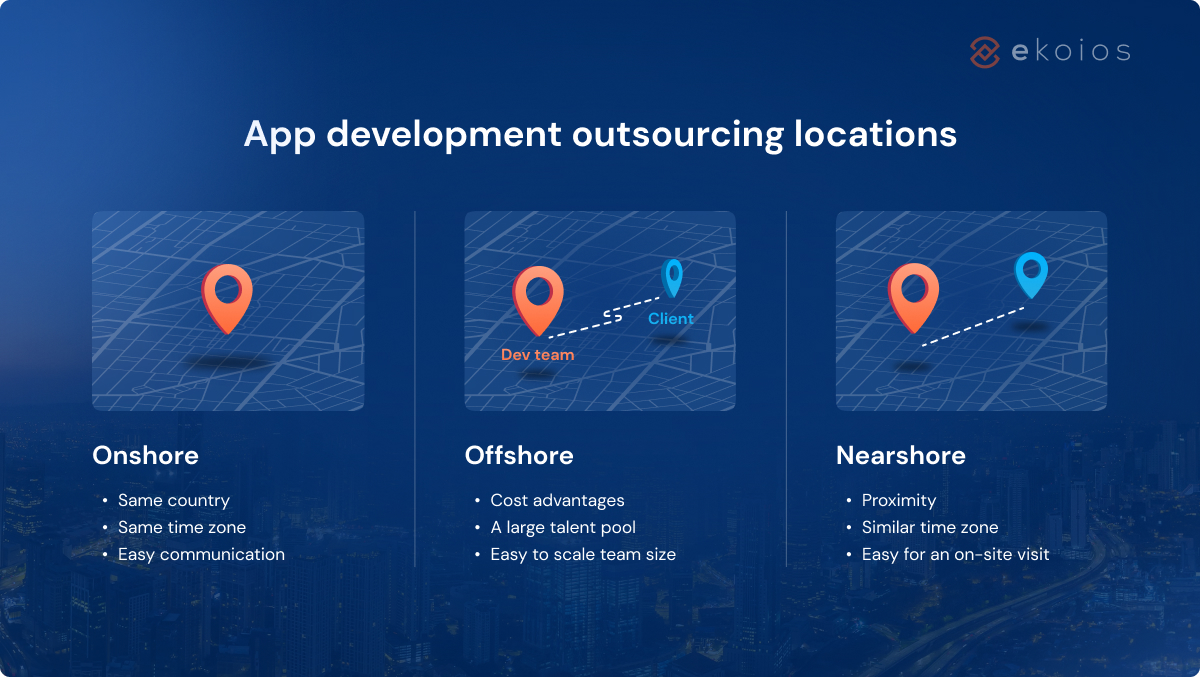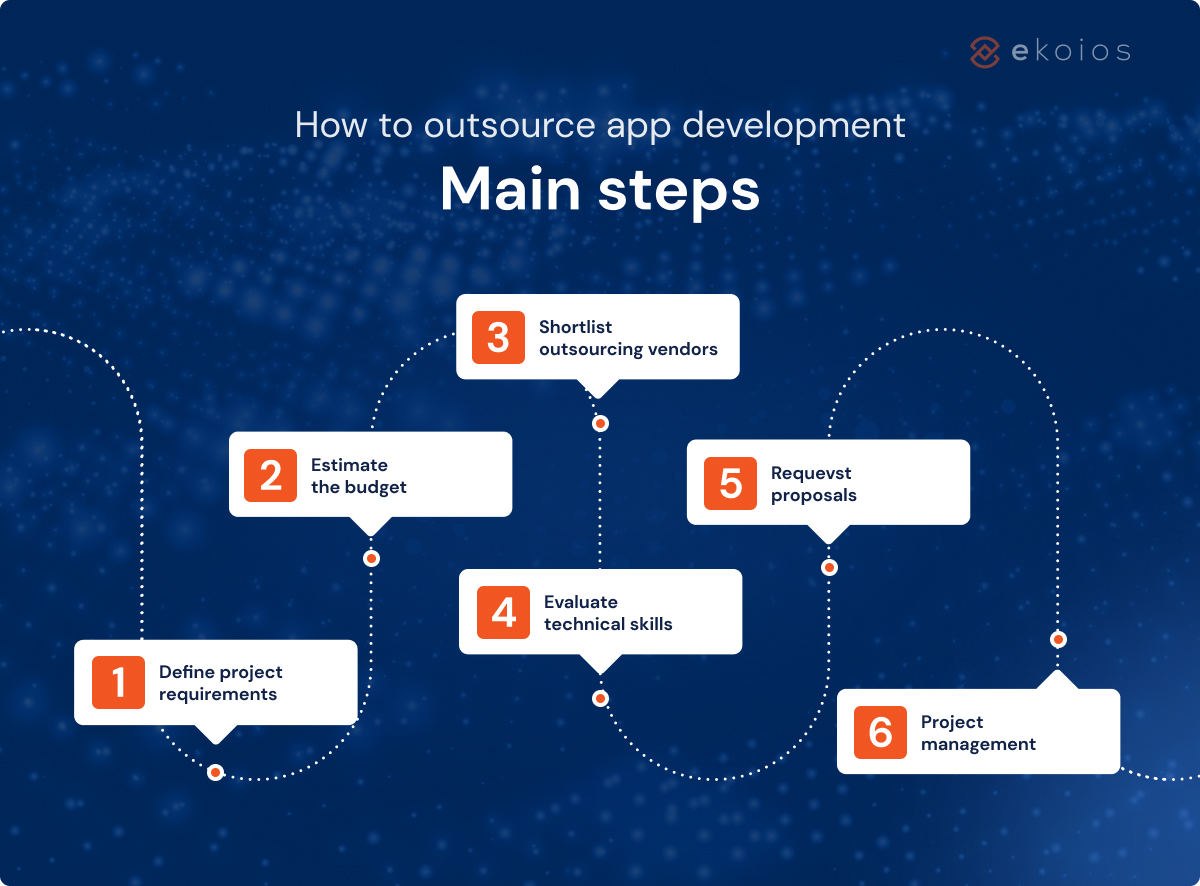
- 1
- 2
- 3
- 4
- 5
- 6
In the era of technology, mobile apps have become an essential element for businesses to interact with customers and gain a competitive edge. Depending on the nature of the business, owning an in-house development team to build an app may not be necessary. Many businesses have opted to outsource app development to save costs and leverage the abundant resources and expertise of an outsourced team. What about you? How can you make the right choice about outsourcing app development? That is the purpose of this blog post – to help you gain a better understanding of outsourcing app development.
Why outsource mobile app development?
Outsourcing mobile app development offers several advantages. First and foremost, it allows companies to tap into a pool of highly skilled professionals who specialize in app development. These professionals bring diverse expertise, knowledge, and experience to the table, ensuring the app is built to the highest standards. In particular, outsourcing companies will better understand the programming languages specific to the operating systems on which the app will run, such as Swift for iOS or Kotlin for Android. This knowledge enables them to develop and program apps that are compatible with each operating system.
Outsourcing also provides access to cutting-edge technologies and innovative solutions. Outsourcing vendors often stay current with the latest industry trends and advancements. Leveraging their expertise can result in a feature-rich and user-friendly app that meets the demands of modern consumers.
Another primary motivation for outsourcing app development is cost savings. Building an in-house development team incurs significant expenses, including hiring costs, salaries, and infrastructure setup. By outsourcing, companies can reduce these costs as they only pay for the services provided by the external team. Moreover, outsourcing to countries in Asia with lower labor costs, such as India or Vietnam, can offer substantial cost advantages without compromising quality.
📌Read more: Why choose Vietnam for outsourcing app development
App development involves inherent risks, such as project delays, budget overruns, and technical challenges. Outsourcing can help mitigate these risks in several ways. First, external teams are experienced in managing app development projects, minimizing the likelihood of delays and cost overruns. Second, outsourcing allows for greater flexibility in resource allocation, making it easier to address unexpected challenges or changes in project scope. Finally, outsourcing vendors often follow robust quality assurance processes, reducing the risk of delivering a buggy application.
By partnering with an external team, businesses can focus on their core competencies while leaving the technical aspects of app development to the experts. This streamlines the development process and accelerates time-to-market.
Outsource app development cost
The cost of outsourcing app development can vary significantly depending on various factors. Understanding these factors and their impact on pricing is crucial for businesses considering outsourcing.
- Tech stack: Different programming languages, frameworks, and libraries have varying levels of complexity and require different skill sets. For example, an app using native technologies, such as Swift for iOS or Kotlin for Android, often involves higher development costs due to the need for specialized expertise. On the other hand, using cross-platform frameworks like React Native or Flutter can offer cost savings as it allows for code reuse across multiple platforms.
- Platform requirements: Developing an app for a single platform (iOS or Android) is generally more cost-effective compared to building for multiple platforms simultaneously. Each platform has its unique design guidelines, development tools, and APIs, which require additional effort and resources. However, using multiple platforms is necessary to reach a broader user base, and the associated cost should be considered accordingly.
📌Read more: Native apps vs. Hybrid apps
- Project scope: The complexity and scope of the app significantly impact the development cost. Factors such as the number of features, user interface intricacy, integration with third-party services, backend development, and data storage requirements all contribute to the overall cost. Apps with more extensive functionality and complex features will generally require more development effort, leading to higher costs.
- App types and price ranges: The cost of app development can also vary based on the type of app.
– Database-driven app: Apps that require data storage, retrieval, and manipulation, such as content management systems or catalogue apps, fall into this category. The cost is estimated to be from $15,000 to $50,000, depending on the complexity of the features and the amount of data involved.
– Social media or marketplace app: These apps involve user profiles, social interactions, and messaging features, and often require integration with third-party APIs. The cost for those apps can vary from $50,000 to $150,000, or even higher for more feature-rich and scalable solutions.
– On-demand or complex enterprise app: Apps with complex functionalities, real-time data synchronization, geolocation services, payment gateways, and advanced backend systems fall into this category. It is recommended to prepare a budget of around $100,000 to $500,000 or more.
It’s important to note that these price ranges are estimates and can vary based on factors such as the geographic location of the outsourcing partner, their level of expertise, and the specific requirements of the project.
Outsource app development models: Key models

- Staff augmentation: Staff augmentation means supplementing the client’s existing in-house team with external resources provided by the outsourcing vendor. The vendor helps fill specific skill gaps or increase the development capacity by providing additional developers, designers, or other relevant professionals. The augmented team members work closely with the client’s in-house team, seamlessly integrating into the existing development process and culture. Businesses can scale their development capacity up or down as needed, without incurring the costs and time associated with hiring, onboarding, and training new employees. Businesses should ensure consistent quality standards and align the augmented team’s work with the required expectations.
- Dedicated team: The dedicated team model involves forming a long-term partnership with an outsourcing vendor to establish a dedicated team of professionals who work exclusively on the client’s app development project. The client retains control over the project’s scope and direction while benefiting from the expertise and resources of the dedicated team. This model offers flexibility in adjusting the team size and composition based on project requirements, allowing businesses to scale up or down as needed. Furthermore, it facilitates a long-term partnership, enabling the outsourcing team to gain a deep understanding of the client’s business, goals, and technical requirements. In contrast, businesses have to manage the dedicated team, including their day-to-day activities, task assignments, and coordination with the internal team.
- Project-based outsourcing: The outsourcing vendor is responsible for delivering the entire app development project from start to finish. The scope, timeline, and cost of the project are defined upfront, and the outsourcing vendor takes care of the development process, including requirement analysis, design, development, testing, and deployment. Thus, businesses have better cost control and predictability. Businesses can focus on their core activities without having to manage the development process. However, as the scope and pricing are defined upfront, it has limited flexibility for accommodating changes or additions during the process.
Choosing the ideal app development outsourcing location

When considering app development outsourcing, businesses have various options for the location of their outsourcing partner. The choice of location can significantly impact the success of the project in terms of cost, communication, and quality. There are 3 primary outsourcing location models: onshore, offshore, and nearshore
- Onshore outsourcing: Onshore outsourcing refers to partnering with a development team located within the same country as the client’s business, sharing the same time zone and cultural context. It is generally more expensive compared to offshore or nearshore options due to higher labor costs in developed countries. For example, the cost of hiring an outsourcing vendor in North America can go up to $250 per hour or more.
- Offshore outsourcing: In the offshore outsourcing model, businesses work with a development team located in a geographically distant country, often with significant cost advantages. These countries typically have lower labor costs compared to developed countries. The hourly cost of outsourcing in Asia countries like India or Vietnam ranges from $20-$50, saving you up to 50% of your budget in comparison to the US or European countries. Offshore locations have a large pool of skilled developers, providing access to a diverse range of expertise and talent. However, businesses may experience communication and collaboration challenges in terms of language barriers, cultural differences, and different time zones.
📌Read more: Software development company in Vietnam can help startups save costs
- Nearshore outsourcing: Partnering with a development team located in a neighboring or nearby country is nearshore outsourcing, typically within the same or similar time zone. This model combines some of the benefits of both onshore and offshore outsourcing. Although not as significant as offshore outsourcing, nearshore locations provide some cost advantages compared to onshore options. When compared to offshore destinations, the nearshore outsourcing model has a relatively smaller talent pool, limiting access to specialized expertise.
How to outsource app development – Main steps

Outsourcing app development requires a systematic approach to ensure a successful partnership with an outsourcing vendor. Here are the main steps involved in the outsourcing process:
- Define project requirements: The first step is to clearly define the project requirements. This includes outlining the project scope, and desired platforms for the app (such as iOS, Android, or web), and identifying the specific functionalities and features the app should have. It helps set clear expectations and provides a foundation for communication with potential outsourcing partners.
- Estimate the budget: Understanding the financial constraints assists in selecting an outsourcing vendor that aligns with the budget and provides the best value for the investment. Consider factors such as development costs, ongoing maintenance, and any additional expenses associated with the project.
- Research and shortlist outsourcing partners: Outsourcing vendor evaluation is a daunting challenge with numerous options available. You should look for companies with relevant experience, expertise in app development, and a track record of successful projects. Some review platforms can provide you with an overall look at reputation, client reviews, and industry recognition, such as Cutch or TechReviewer. Shortlist a few vendors that seem most suitable for your project.
- Evaluate technical skills: When you have a list of potential outsourcing vendors, the next step is to assess their portfolio, case studies, and client testimonials. You can ask them about their capability to handle projects similar to yours. Those capabilities include technology stack expertise, development methodologies, and the ability to deliver high-quality code.
- Request proposals: The proposals should include information on the chosen outsourcing model (project-based, dedicated team, or staff augmentation), contract terms, estimated timeline, cost breakdown, expected deliverables, and any warranty or support terms. Evaluate the proposals carefully to determine which vendor best meets your requirements and aligns with your budget.
- Project management and communication: Once you have selected an outsourcing partner, the next step is to establish clear project management and communication protocols. Define the project milestones, establish regular progress reporting, and agree on the communication channels and frequency of meetings. This helps maintain transparency, fosters effective collaboration, and ensures that the project progresses as planned.
Conclusion
Outsourcing app development can be a strategic decision for companies looking to build high-quality mobile applications while saving time and resources. The process of outsourcing app development requires careful consideration and research to find the right outsourcing vendor that aligns with the unique needs of each company. Understanding the specific requirements and evaluating potential vendors are crucial steps in establishing a long-term and successful partnership. If you are planning to develop an app but are unsure of where to begin, Ekotek experts are here to assist you. Feel free to reach out to us for support and guidance on your outsource app development journey.
- 1
- 2
- 3
- 4
- 5
- 6